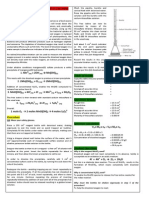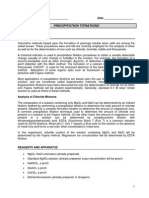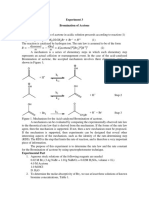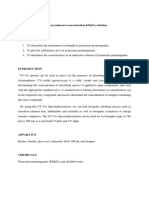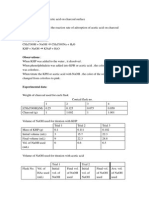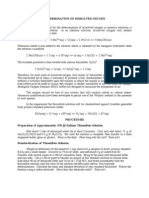Titration Curves of Strong and Weak Acids and Bases
Titration Curves of Strong and Weak Acids and Bases
Uploaded by
Matthew RunyonCopyright:
Available Formats
Titration Curves of Strong and Weak Acids and Bases
Titration Curves of Strong and Weak Acids and Bases
Uploaded by
Matthew RunyonCopyright
Available Formats
Share this document
Did you find this document useful?
Is this content inappropriate?
Copyright:
Available Formats
Titration Curves of Strong and Weak Acids and Bases
Titration Curves of Strong and Weak Acids and Bases
Uploaded by
Matthew RunyonCopyright:
Available Formats
Titration Curves of Strong and Weak Acids and Bases
12/20/11
Purpose: The purpose of this lab is to observe differences in the shapes of titration curves of various strengths of acids and bases when combined, to learn about the function and selection of appropriate acid-base indicators, and to experimentally determine the equivalence point of strong and weak acid and base titrations.
Background: An acid-base titration is when one solution is added from a buret (the titrant) to another solution in a beaker below until all of the solution in the beaker has been neutralized by the titrant. To show when the neutralization is complete, an indicator is added to the solution in the beaker. An indicator is a compound whose conjugate acid or base color is different from its normal acid or base color. This indicator will show us the endpoint, or point at which the color of the indicator changed. This is usually near the equivalence point, or the point at which the number of moles of Hydrogen ions is equal to the number of moles of Hydroxide ions. A good indicator will change colors about 1pH point below an acid s equivalence point, or 1 pH point above a base s equivalence point. The titration curve should start out with a very gradual change, but around the equivalence point have a sudden and dramatic change in pH, then go back to gradual change after the equivalence point.
Materials: y y y y y y y y y CBL 2 DataMate Program magnetic stirrer 250-mL beaker Stopwatch 0.10M NH3 solution 0.10M HC2H3O2 solution Ring stand Distilled water y y y y y y y y y TI Graphing Calculator pH Sensor stirring bar Phenolphthalein 0.10M NaOH solution 0.10M HCl solution 50-mL buret 2 utility clamps Wash bottle
Procedure: 1. Obtain and wear goggles. 2. Put 8 mL of 0.10M HCl solution into a 250-mL beaker. Add about 100mL of distilled water. Add 3 drops of PHP indicator. 3. Place a magnetic stirrer in the beaker and put it on a magnetic stirring plate. 4. Plug the pH sensor into the CBL 2 and connect the graphing calculator to the CBL 2. 5. Use a utility clamp to suspend the pH sensor on a ring stand to where it will be in the solution, but not disturbed by the stirring bar. 6. Rinse a 50-mL buret with a few mL of 0.10M NaOH solution. Fill the buret to the 0-mL mark. 7. Turn on the calculator and start the DataMate Program. 8. Set up the calculator for the pH sensor. 9. To set up data collection mode: Select mode, press up, and enter. Select time graph. Change time settings to 3 in between samples and 80 as number of samples. Select ok twice to return to the main screen. 10. Turn on the magnetic stirrer. Press start on both the calculator and a stopwatch. Open the buret to a drop rate of about 1 drop per second. 11. Record the time of the color change. 12. When data collection stops, close the buret. Find the largest jump in pH from your data and record that as the equivalence point. Dispose of the solutions, then clean the beaker and buret for the next trial. 13. Print the graph of the pH vs. Time Elapsed. Print the data table. 14. Repeat steps 2-13 using NaOH titrant and acetic acid solution, HC2H3O2. 15. Repeat steps 2-13 using NH3 titrant and HCl solution. 16. Repeat steps 2-13 using NH3 titrant and acetic acid solution, HC2H3O2.
Observations: In all of the titrations, the PHP started off clear and then turned red, indicating an increase in pH. The drop rate from the buret slowed down as the trials went on, and the buret had to be opened a little further to adjust and keep the interval as even as possible. This was due to the weight of the solution in the buret decreasing because the volume was decreasing, so it had less force to move out of the tiny hole in the buret. Questions: 1. In which trial did the indicator change color at about the same time as the large increase in pH occurred at the equivalence point? In which trials were there a significant difference in these two times.
In trial 2, the indicator color change time was closeset to the equivalence point. In trials 1, 3, and 4, the indicator color change was not very close to the equivalence point. 2. According to your results, with which combination(s) of strong or weak acids and bases can phenolphthalein be used to determine the equivalence point? Phenolphthalein can be used to determine the equivalence point fairly well with the weak acid being titrated by a strong base. 3. Compare your answers to Questions 1 and 3. By examining a titration curve, how can you decide which acid-base indicator to use to find the equivalence point? You can determine the indicator to use by looking at the titration curve and finding the pH near the bottom of the steep increase or decrease in pH. A good indicator would start to change colors around this point. 4. This question was a repeat of 3 on the sheet. 5. Methyl red is an acid-base indicator that changes color at a pH value of about 5. From what you learned in this lab, methyl red could be used to determine the equivalence point of which combination of strong or weak acids and bases? Methyl red could be used to determine the equivalence point of the weak base NH3 and the strong acid HCl because this titration s equivalence point was around 6.3. 6. Of the four titration curves, which combination of strong or weak acids and bases had the longest vertical region of the equivalence point? The shortest? The longest vertical region was from the NaOH and HC2H3O2 titration. The shortest curve was from the NH3 and HCl titration as this graph was not a very good curve for us. 7. The acid-base reaction between HCl and NaOH produces a solution with a pH of 7 at the equivalence point (NaCl + H2O). Why does an acid-base indicator that changes color at pH 5 or 9 work just as well for this reaction as one that changes color at pH 7? If an indicator changes at 5 or 9, these average out to 7, so this indicator will give you the time of pH 5 and 9, of which the middle of these times would be pH 7. 8. In general, how does the shape of a curve with a weak specie (NH3 or HC2H3O2) differ from the shape of a curve with a strong specie (NaOH or HCl)? The curve of a weak species differs in that the initial pH is higher and the peak pH is lower.
You might also like
- Lab Report Acid BaseDocument4 pagesLab Report Acid Basexuni34No ratings yet
- 8 - Lab8-Potentiometric Titration of Acid MixtureDocument6 pages8 - Lab8-Potentiometric Titration of Acid MixtureHoang Huong TraNo ratings yet
- Experiment 3 Redox Titration Percent Purity AnalysisDocument5 pagesExperiment 3 Redox Titration Percent Purity AnalysisnanaNo ratings yet
- Gravimetric Determination of Moisture CoDocument5 pagesGravimetric Determination of Moisture CoDEFIN BIMA REYNANDANo ratings yet
- Gravimetry Lab Report Experiment 01Document4 pagesGravimetry Lab Report Experiment 01PDPPPMAT0621 Ruhilin Binti NasserNo ratings yet
- Chemical Kinetics: The Iodine Clock Reaction: J. CortezDocument6 pagesChemical Kinetics: The Iodine Clock Reaction: J. CortezKyle CortezNo ratings yet
- Experiment Report: Spectrophotometric Analysis of Caffeine and Benzoic Acid in Soft DrinkDocument12 pagesExperiment Report: Spectrophotometric Analysis of Caffeine and Benzoic Acid in Soft DrinkNitty MeYaNo ratings yet
- Chem 160.1 Ex2 BufferDocument8 pagesChem 160.1 Ex2 BufferAsi JenNo ratings yet
- LAB Report 3Document8 pagesLAB Report 3Phương Vân0% (1)
- Determining Equilibrium Constant Lab-U3Document7 pagesDetermining Equilibrium Constant Lab-U3Muhamamd IdreesNo ratings yet
- The Titration of Acetic Acid in VinegarDocument3 pagesThe Titration of Acetic Acid in VinegarGladies AlvarNo ratings yet
- AP Chemistry - Titration Curves of Strong and Weak Acids and BasesDocument5 pagesAP Chemistry - Titration Curves of Strong and Weak Acids and BasesJonathan Chen100% (2)
- Lab Experiment 3 Ka Determination Through PH TitrationDocument4 pagesLab Experiment 3 Ka Determination Through PH TitrationxmusiqaNo ratings yet
- KHP LabDocument5 pagesKHP LabSantino MusaNo ratings yet
- Liquid Liquid ExtractionDocument36 pagesLiquid Liquid ExtractionamirnimoNo ratings yet
- CHEM 334L - Conductance of Solutions - Estimating K For A Weak AcidDocument4 pagesCHEM 334L - Conductance of Solutions - Estimating K For A Weak Acidfdobonat613100% (1)
- Titration CurveDocument4 pagesTitration CurveElaine CortesNo ratings yet
- Determination of PH of Common Solutions Using PH Paper and PH MeterDocument2 pagesDetermination of PH of Common Solutions Using PH Paper and PH MeterKeziah Casco CortadoNo ratings yet
- Lab ReportDocument9 pagesLab ReportmawarNo ratings yet
- Titration Lab ReportDocument25 pagesTitration Lab Reportapi-428944081No ratings yet
- Determination of Chloride by Volhard and Mohr MethodDocument6 pagesDetermination of Chloride by Volhard and Mohr MethodShane AmolarNo ratings yet
- Chem 26.1 DataDocument2 pagesChem 26.1 Datagamingonly_accountNo ratings yet
- Acid Base TitrationDocument7 pagesAcid Base TitrationAinul Diyana100% (1)
- Abstract (Lab 2) Ionization ConstantDocument12 pagesAbstract (Lab 2) Ionization Constantmirdza94No ratings yet
- Ion-Selective Electrode Determination of Fluoride Ion: Chemistry 321L ManualDocument5 pagesIon-Selective Electrode Determination of Fluoride Ion: Chemistry 321L Manuallsueyin100% (1)
- Determination of The Solubility Product Constant of Calcium Hydroxide Chem 17Document7 pagesDetermination of The Solubility Product Constant of Calcium Hydroxide Chem 17Frances Abegail QuezonNo ratings yet
- Dissolved Oxygen by Redox TitrationDocument2 pagesDissolved Oxygen by Redox TitrationSuet Wan GohNo ratings yet
- THE IODINE CLOCK REACTION: Effect of Ionic Strength On Reaction RateDocument6 pagesTHE IODINE CLOCK REACTION: Effect of Ionic Strength On Reaction RateDannah Joy GamilNo ratings yet
- Titrimetric Methods of Analysis 2Document30 pagesTitrimetric Methods of Analysis 2Isnehaya BangcolaNo ratings yet
- Titration Lab ReportDocument20 pagesTitration Lab Reportapi-410426030No ratings yet
- Qualitative Organic Analysis - Sem 3Document37 pagesQualitative Organic Analysis - Sem 3Reshma SomanNo ratings yet
- Argento Me TryDocument5 pagesArgento Me TryGino GalanoNo ratings yet
- The Fluoride Ion Selective Electrode ExperimentDocument5 pagesThe Fluoride Ion Selective Electrode Experimentlisaaliyo0% (1)
- Chemistry 12 - Unknown Acid Base Titration LabDocument6 pagesChemistry 12 - Unknown Acid Base Titration LabarasurtNo ratings yet
- Determination Acetic AcidDocument21 pagesDetermination Acetic Acidameyakem100% (1)
- Analysis of A Mixture of Carbonate and BicarbonateDocument2 pagesAnalysis of A Mixture of Carbonate and BicarbonateCharles Trono RacadioNo ratings yet
- Laboratory Report of Melting PointDocument5 pagesLaboratory Report of Melting PointHanna Anne88% (8)
- Experiment 3 - Bromination of AcetoneDocument12 pagesExperiment 3 - Bromination of AcetoneOsama AnatyNo ratings yet
- Titration Lab ReportDocument5 pagesTitration Lab ReportvaiNo ratings yet
- Absorption Spectrum of A Conjugated DyeDocument6 pagesAbsorption Spectrum of A Conjugated DyeKing Everest100% (1)
- Exp11 Electrical - Conductivity.sum17 1Document13 pagesExp11 Electrical - Conductivity.sum17 1Kristine Mae CandaNo ratings yet
- Chem 2 Weak Base Strong Acid Lab ReportDocument6 pagesChem 2 Weak Base Strong Acid Lab ReportMohammad Izadi100% (1)
- Atq 4Document4 pagesAtq 4Martina BlasNo ratings yet
- Determination of Acid Content of Vinegars and Wines Lab ReportDocument3 pagesDetermination of Acid Content of Vinegars and Wines Lab ReportAlleia Mae Urbano MazoNo ratings yet
- Title Uv-Vis Determination of An Unknown Concentration Kmno SolutionDocument4 pagesTitle Uv-Vis Determination of An Unknown Concentration Kmno SolutionMuhammad Amirul AfifiNo ratings yet
- ADSORPTIONDocument6 pagesADSORPTIONSatyamGupta0% (1)
- Formal Report Experiment 2 and 3Document5 pagesFormal Report Experiment 2 and 3Zyra Camille Giron HacheroNo ratings yet
- Spectrometric Determination of The Acid Dissociation Constant of Methyl RedDocument11 pagesSpectrometric Determination of The Acid Dissociation Constant of Methyl Redエンパーラナー カイザー ニロNo ratings yet
- 11 7 Ka1 For H3PO4 Titrn PDFDocument6 pages11 7 Ka1 For H3PO4 Titrn PDFGaotingweNo ratings yet
- Antacid Analysisrty4Document4 pagesAntacid Analysisrty4Melced BenasasNo ratings yet
- Chem 26 1 Midterms ReviewDocument15 pagesChem 26 1 Midterms ReviewAlyzza Victoria TorresNo ratings yet
- DiscussionDocument3 pagesDiscussionSiti HajarNo ratings yet
- EXPERIMENT 5 Common Ion EffectDocument4 pagesEXPERIMENT 5 Common Ion EffectNat DabuétNo ratings yet
- Adsorption of Acetic Acid On Charcoal SurfaceDocument3 pagesAdsorption of Acetic Acid On Charcoal SurfaceFrankyFan90% (10)
- Determination of Dissolved OxygenDocument2 pagesDetermination of Dissolved OxygenMartk MartinezNo ratings yet
- Preparation of A Standard Acid SolutionDocument4 pagesPreparation of A Standard Acid SolutionfaithNo ratings yet
- Copper Determination in Water by Standard Addition PotentiometryDocument4 pagesCopper Determination in Water by Standard Addition PotentiometryAura Ballesteros MontealegreNo ratings yet
- Experiment 3: Neutralization Capacity of Commercial Antacid AcidDocument10 pagesExperiment 3: Neutralization Capacity of Commercial Antacid AcidfizaNo ratings yet
- Che Exp 2 LatestDocument6 pagesChe Exp 2 LatesttkjingNo ratings yet
- Sinha TitrationcurvesDocument11 pagesSinha TitrationcurvesRadu StafiNo ratings yet


























